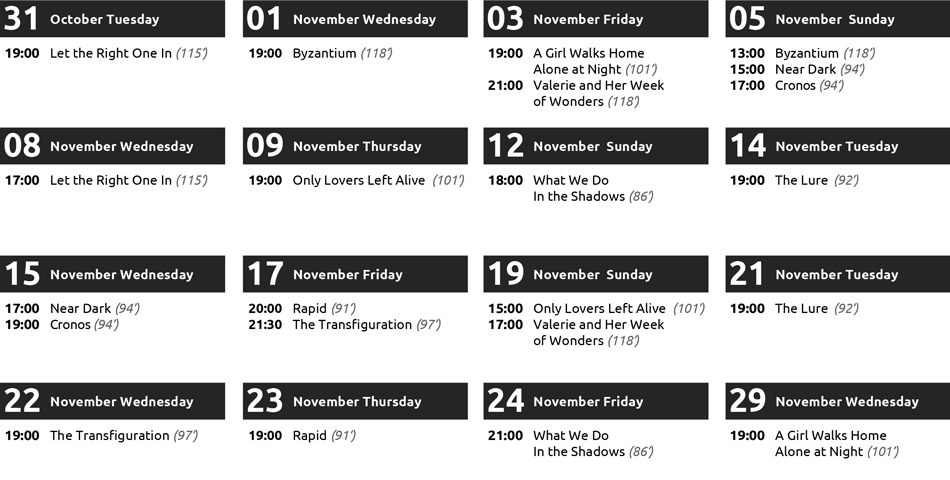Pera Film is celebrating Halloween with the most strangest undead beings: Unusual Vampires! Tales of supernatural beings consuming the blood or flesh of the living have been found in nearly every culture around the world for many centuries. The Oxford English Dictionary dates the first appearance of the English word vampire (as vampyre) in English from 1734, in a travelogue titled Travels of Three English Gentlemen published in The Harleian Miscellany in 1745. The notion of vampirism has existed for millennia. Cultures such as the Mesopotamians, Hebrews, Ancient Greeks, and Romans had tales of demons and spirits, which are considered precursors to modern vampires. The charismatic and sophisticated vampire of modern fiction was born in 1819 with the publication of The Vampyre by John Polidori; the story was highly successful and arguably the most influential vampire work of the early 19th century. Bram Stoker’s 1897 novel Dracula is remembered as the quintessential vampire novel and provided the basis of the modern vampire legend. Considered one of the preeminent figures of the classic horror film, the vampire has proven to be a rich subject for cinema. Pera Film’s Unusual Vampires brings together films that explore the atypical vampire character. The selection salutes certain cult classics such as Czechoslovak New Wave’s 1970 production of Jaromil Jireš’s Valerie and Her Week of Wonders, a film about a girl on the verge of womanhood who finds herself in a sensual fantasyland of vampires, witchcraft, and otherthreats in this eerie and mystical movie daydream. David Cronenberg’s 1977 film Rabid, Guillermo del Toro’s Cronos and Kathryn Bigelow’s Near Dark explore different decades and alternative approaches to the vampire story-telling. The program also includes recent films with unexpected and gripping characters, so you will love and some you will hate. Beware these unusual vampires could give you the chills!

October 1
October 31
19:00 Let the Right One In
November 1
19:00 Byzantium
November 3
19:00 A Girl Walks Home Alone at Night
21:00 Valerie and Her Week of Wonders
November 5
13:00 Byzantium
15:00 Near Dark
17:00 Cronos
November 8
17:00 Let the Right One In
November 9
19:00 Only Lovers Left Alive
November 12
18:00 What We Do in the Shadows
November 14
19:00 The Lure
November 15
17:00 Near Dark
19:00 Cronos
November 17
20:00 Rabid
21:30 The Transfiguration
November 19
15:00 Only Lovers Left Alive
17:00 Valerie and Her Week of Wonders
November 21
17:00 The Lure
November 22
19:00 The Transfiguration
November 23
19:00 Rabid
November 24
21:00 What We Do in the Shadows
November 28
November 29
19:00 A Girl Walks Home Alone at Night
December 9
October 31
19:00 Let the Right One In
November 1
19:00 Byzantium
November 3
19:00 A Girl Walks Home Alone at Night
21:00 Valerie and Her Week of Wonders
November 5
13:00 Byzantium
15:00 Near Dark
17:00 Cronos
November 8
17:00 Let the Right One In
November 9
19:00 Only Lovers Left Alive
November 12
18:00 What We Do in the Shadows
November 14
19:00 The Lure
November 15
17:00 Near Dark
19:00 Cronos
November 17
20:00 Rabid
21:30 The Transfiguration
November 19
15:00 Only Lovers Left Alive
17:00 Valerie and Her Week of Wonders
November 21
17:00 The Lure
November 22
19:00 The Transfiguration
November 23
19:00 Rabid
November 24
21:00 What We Do in the Shadows
November 29
19:00 A Girl Walks Home Alone at Night
Program Trailer
Tuesday - Saturday 10:00 - 19:00
Friday 10:00 - 22:00
Sunday 12:00 - 18:00
The museum is closed on Mondays.
On Wednesdays, the students can
visit the museum free of admission.
Full ticket: 300 TL
Discounted: 150 TL
Groups: 200 TL (minimum 10 people)